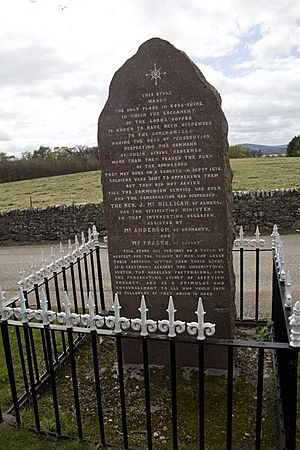John M'Gilligen facts for kids
Quick facts for kids John M'Gilligen |
|
|---|---|

Dalmore Conventicle Stone, Alness (transcription below)
|
|
| Personal details | |
| Died | 8 June 1689 |
| Denomination | Presbyterian |
John M'Gilligen was a brave Presbyterian minister who lived in the 1600s. During his time, the government wanted everyone to follow the Episcopalian church, which had bishops. But John M'Gilligen and other Presbyterians believed their church should be led by elders, not bishops. Because he stood up for his beliefs, he was put in prison, including on a famous island prison called the Bass Rock. You might also see his name spelled as John MacKilligen or John M'Killican.
Contents
John M'Gilligen's Early Life and Ministry
John M'Gilligen became a minister in 1656 in a place called Fodderty, near Dingwall in Scotland. At this time, the government passed a law saying that ministers had to get permission from the local Bishop to keep their jobs. John M'Gilligen refused to do this because he didn't believe in bishops.
Because he wouldn't follow the new rules, he was removed from his church job in 1662. The Bishop of Ross even tried to remove him from being a minister entirely, but John M'Gilligen didn't care about this order.
Preaching in Secret Meetings
After losing his church, John M'Gilligen moved to Alness. He started holding secret religious meetings called "conventicles" in private homes or outdoors. These meetings were against the law, but many people came to hear him preach. His success made the Bishop very angry.
In 1667, complaints were made against him for holding these secret meetings with another minister, Thomas Hog. The next year, he was put in jail in Forres. After he was released, he went back to Alness and continued preaching.
Outlawed for His Faith
In 1674, John M'Gilligen was ordered to appear before the Privy Council, a powerful government group. He didn't go, so they declared him an "outlaw." This meant he was officially a rebel against the King.
Even as an outlaw, he kept preaching. In 1675, he even led a special church service called the Lord's Supper at a lady's house in Obsdale.
Imprisonment on the Bass Rock
Early in 1676, John M'Gilligen was finally caught and taken to Fortrose. He was then sent to Edinburgh and later to the Bass Rock. This was a very tough prison on a small island in the sea. He stayed there for almost two years, from 1677 to 1679.
Life on the Bass Rock was hard. He wasn't allowed to have anyone help him with chores. But eventually, he was sometimes allowed to walk around the rock, which he enjoyed. He was finally set free in July 1679.
More Arrests and Imprisonment
As soon as he was free, John M'Gilligen went right back to preaching. But in 1682, the government found out he was still holding secret meetings and performing baptisms and marriages without permission. He was fined a huge amount of money and sent back to prison in Edinburgh.
In 1683, he was fined again and, after six months, sent back to the Bass Rock for a second time. He stayed there until 1686. He only left because he became very sick and was allowed to go home to Alness.
Life After Persecution
In 1687, the government finally allowed Presbyterians to practice their faith more freely. John M'Gilligen used money he received for damage done to his property to build a new meeting-house in Alness.
He was asked to be a minister in Elgin and Inverness, but he didn't take those jobs. John M'Gilligen passed away on June 8, 1689, and was buried in Inverness.
John M'Gilligen's Family
John M'Gilligen married Catherine Munro and they had several children, including two sons who also became ministers: John, who served in Lochalsh, and Daniel, who served in Alness. He later married Margaret Mackenzie.
His Lasting Impact
There's a special stone called the Dalmore Conventicle Stone in Alness. It marks the only known place in that area where the Lord's Supper was given to Covenanters (Presbyterians who signed agreements to defend their faith) during the time they were being persecuted.
The stone says that John M'Gilligen led this service in September 1675. Soldiers were sent to arrest them, but they arrived too late, after the service was over and everyone had left. The stone was put there to remember these brave people who loved their faith more than their own lives.
John M'Gilligen's family story, including his own, is even featured in a historical fiction novel called Across the Deep.


